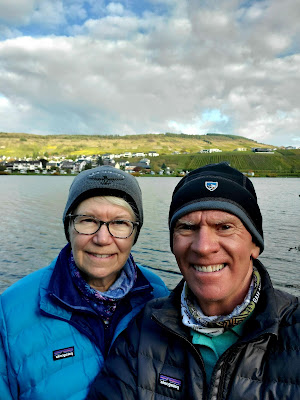Guten Morgen from Trier, Germany
We awoke this morning in Trier. It was founded by Augustus in 16 BC and later built as a capital of the western part of the Roman Empire, which today is most of Germany.
We meet our local guide, Manfred, near the old town wall. In Roman times, the town was surrounded by a four-mile wall with four large gates.
Only this northern gate survives. It is the most impressive Roman fortification in Germany.
It was built without mortar--only iron pegs hold the sandstone blocks together.
The other 3 gates of the city were destroyed by medieval metal and stone scavengers. This gate survived because it became a church--a lay church on the bottom and a monastery church on top.
It is called Porta Nigra, or "the black gate". The sandstone which was once light colored has turned dark over time.
We follow Manfred from the gate into the town center. On the way we pass by the statue of Karl Marx. He was born in Trier and lived here until he left for college at age 17.
We reach the Market Square and he points out this building. It is the Dreikonigenhaus or House of the Three Magi.
Today it is a coffee shop. This Venetian-style building was built in the 13th century. Manfred pointed out the door, which seems to be floating, part way up the building on the right. He explained that rich people kept their gold and silver inside their homes. And everyone knew it.
So to fortify the house, protecting it from thieves, the entry would be accessible only by a wooden staircase that could be pulled up and inside when necessary.
The square is lined with beautiful half timbered houses.
On the far end of the square is St. Peter's Cathedral, the oldest Christian church in Germany. In medieval times, the cathedral was its own walled city, and the archbishop of Trier was one of the seven German electors who chose the Holy Roman Emperor. This gave the archbishop tremendous political, as well as spiritual, power.
The townspeople had centuries-long conflict with the archbishop of the church. They wanted Trier to be a free imperial city, serving only the Holy Roman Emperor, not a local archbishop.
The archbishop erected this stone cross in the square to show the townspeople the power that he had.
On a corner of the marketplace is the 15th century Town Hall.
The people wanted a town hall but the archbishop wouldn't allow it as he wanted power over the people. So, the people built an "assembly hall" instead, with a knight on each second-story corner. One knight watching over the people; the other knight, with his hand on his sword, ready for battle.
Another sign of the tension that existed between the archbishop and the townspeople is the Gothic tower of the Church of St. Gangolf. In 1507, Trier's mayor built this tower to make the people's church higher than the cathedral. On top is the inscription is a Bible verse that reads, "Stay awake and pray"
So, in retaliation, the archbishop raised one of the cathedral's towers and topped it with a message...
"For you never know the hour when the Lord will come."
One final look at the market square and then Manfred moves us along to the Konstantin Basilica, the largest intact Roman structure outside of Rome. It is best known as a basilica, but it actually started out as a throne room for the Roman emperors.
Kings used it throughout the Middle Ages, and by the 12th century the archbishops had taken it over, using it as a palace.
The building became a Lutheran church in 1856. We were able to go inside for just a few minutes to see the massive interior.
The Romans were geniuses at engineering. There is a 65 foot arch and there are no columns adding support in the building.
It's hard to see in this photo but there are small rectangular holes between the windows on the wall. These were chimneys which vented hot air that circulated below the floor to heat this enormous space.
The organ for today's church.
Outside, we rounded the corner and saw the Elector's Palace. This building was added to the basilica in the 18th century to house the archbishop-elector. Today it is local government offices.
We ended our time in Trier with a closeup view of St. Peter's Cathedral, the oldest Christian church in Germany.
After Emperor Constantine legalized Christianity in the Roman Empire in 312 AD, his mother allowed part of her palace in Trier to be used as the first church on this spot.
In 326 AD Constantine began the construction of two great churches--St. Peter's in Rome and this huge cathedral in Trier, also called St. Peter's.
After lunch in a local restaurant, we headed back to the ship and took the opportunity to walk along the river a bit and reflect on all we had seen. Manfred was an excellent guide for our day in Trier. He took us back through the centuries.
After dinner we were entertained on the ship by a local dance group, "Winzertanzgruppe Mehring".
To continue reading, scroll down and click on "Newer Posts". We head to Luxembourg tomorrow.































No comments:
Post a Comment